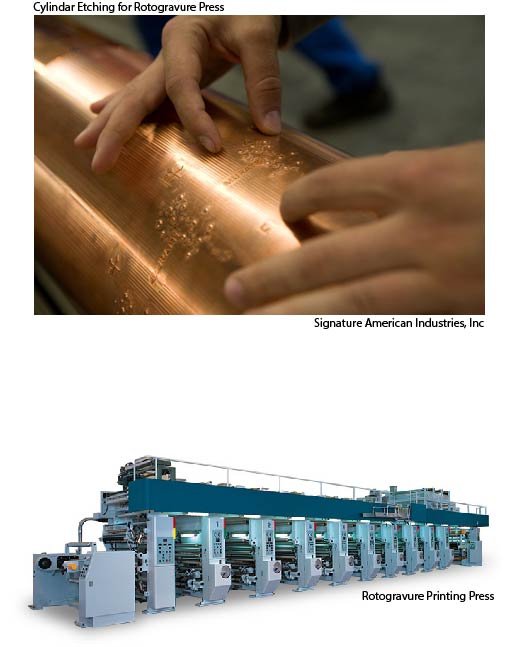Rotogravure Printing
Our offshore production facilities in Taiwan, South Korea and China
The rotogravure process is a direct transfer method for printing onto wood-pulp fiber based, synthetic, or laminated substrates, including:
- Papers
- Films such as polyester, OPP, nylon, and PE
- Carton board
- Aluminum foil
The modern day rotogravure printing press uses a printing cylinder which has been laser engraved with minute cells capable of retaining ink, the size and pattern of which reflect the required image. These cells are forced to transfer their ink directly onto the substrate by a combination of pressure and capillary action, so producing the printed image.
The process, also commonly called gravure printing, is used in the manufacturing of food and non-food packaging, as well as labels, wall coverings, transfer printing, and has a variety of further applications in the security printing, industrial, and tobacco segments of industry.

Rotogravure printing presses
The layout of a gravure printing press follows an in-line arrangement where the required number of printing units is installed along a horizontal plane. In a conventional gravure printing press, each unit comprises of:
- Printing cylinder : a seamless tubular sleeve or full cylinder, made from either steel, aluminum, plastic, or composite material, which is engraved with the image to be printed
- Doctor blade : the device that removes ink from the non-engraved portions of the printing cylinder and also removes excess ink from the engraved sections
- Impression roller : a rubber covered sleeve that is mounted on a steel mandrel. Its primary purpose is to press the substrate against the printing cylinder
- Inking system: consisting of an ink pan, ink holding tank, and ink pump with supply and return ink pipes
- Drying system : consisting of a chamber which dries the ink once it is on the substrate and prior to it reaching the next printing unit. Drier capacities are determined based on the required printing speed, ink type (solvent or water based), and ink lay down volumeProcess description
During the gravure printing process the printing cylinder rotates in the ink pan where the engraved cells fill with ink. As the cylinder rotates clear of the ink pan, any excess ink is removed by the doctor blade. Further around, the cylinder is brought into contact with the substrate, which is pressed against it by the rubber covered impression roller.
- The pressure of the roller, along with the capillary draw of the substrate, results in the direct transfer of ink from the cells in the printing cylinder to the surface of the substrate. As the printing roller rotates back into the ink pan, the printed area of the substrate proceeds through a dryer and onto the next printing unit, which is normally a different color or may be a varnish or coating.
Precise color to color registration is made possible via automatic side and length register control systems.
For a web-fed printing press, after each color has been printed and any coatings applied, the web is ‘rewound’ into a finished roll.
Process advantages and applications
The process offers the ability to transfer ink consistently, across a wide range of densities, and at high speeds, making it suitable for applications which require high image quality, such as publishing, packaging, labels, security print, and decorative printing.
The durable nature of the printing cylinders used makes gravure printing an ideal process for providing high quality print on very long or regularly repeating runs, delivering cost advantages over other processes.










